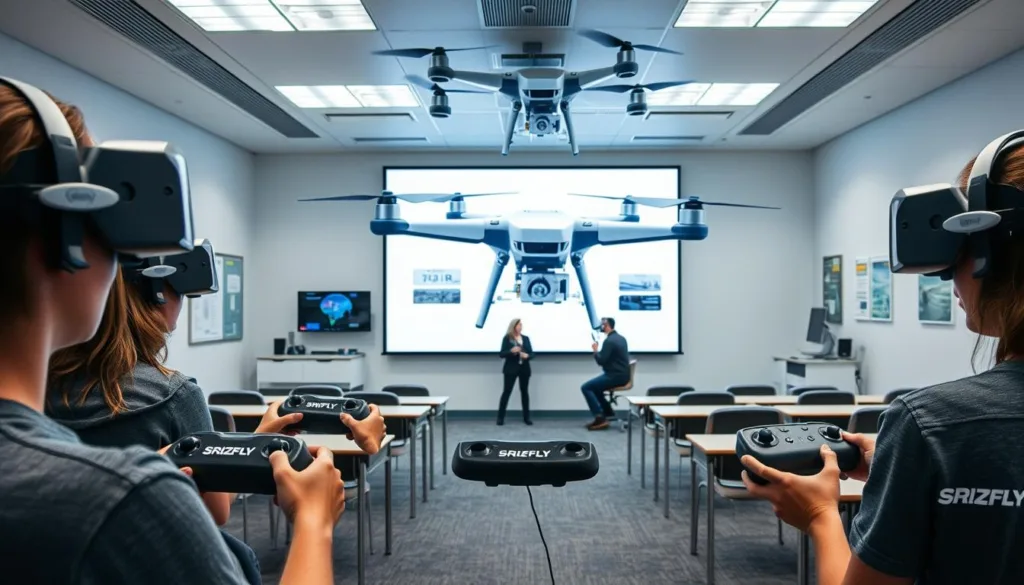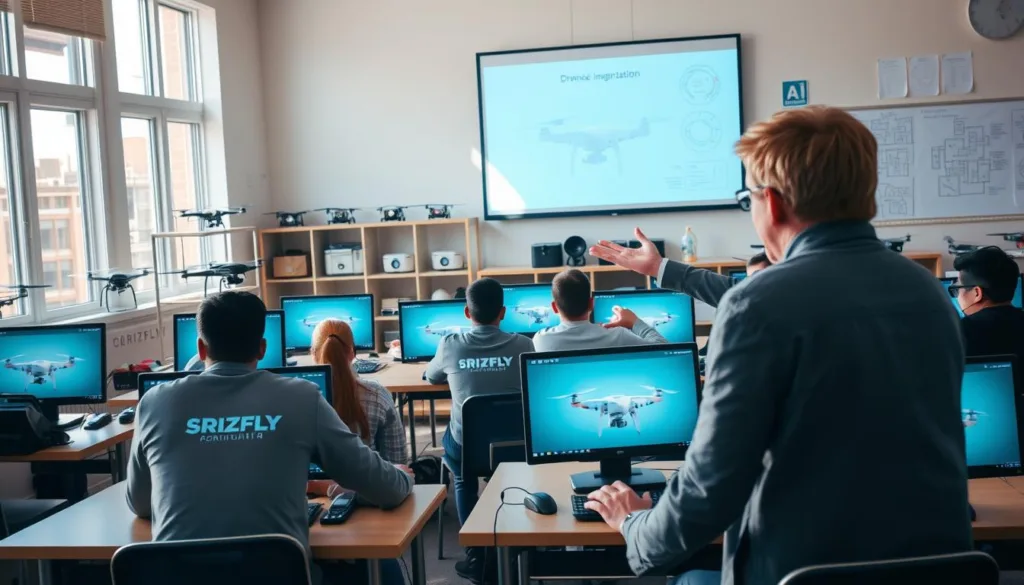Modern education thrives when it connects classroom learning to real-world skills. Across the U.S., schools are embracing drone technology to prepare students for careers in fields like agriculture, emergency services, and filmmaking. Take Cambridge High School in Ohio: their pilot program helped four teens and a teacher ace the FAA Part 107 exam last winter—all on their first try.
What made their success possible? Schools now use advanced flight simulators to teach complex maneuvers without risking expensive equipment. These tools let learners practice for hours in risk-free environments, building confidence before handling physical drones. Educators report higher engagement in STEM courses when using interactive aviation lessons.
Simulators also solve budget challenges. Instead of buying multiple drones, institutions can train entire classes simultaneously. This approach aligns with growing demand for aviation professionals—a sector projected to grow 13% by 2030. Programs blend theory with hands-on practice, giving learners job-ready skills employers value.
Key Takeaways
- Schools using drone simulators see improved test pass rates and student engagement
- Flight training software reduces equipment costs by up to 70% compared to physical drones
- Interactive lessons help students master FAA regulations and flight techniques
- Aviation programs prepare learners for high-growth careers across 8+ industries
- Simulators allow safe practice of emergency procedures and complex maneuvers
Introduction to Drone Education in Schools
Industries from farming to film production now rely on skilled operators of unmanned aircraft. This shift has created exciting opportunities for drone education programs that bridge classroom concepts with career-ready abilities. Schools adopting these tools equip learners with expertise in one of today’s fastest-growing technical fields.
Preparing Tomorrow’s Aviation Workforce
The aviation industry needs 200,000 new professionals by 2032, with drone specialists leading this demand. From crop monitoring to infrastructure inspections, employers seek pilots who understand both flight mechanics and industry-specific applications. Programs using realistic simulators let students log crucial practice hours while mastering safety protocols.
Simulators: The Future of Flight Lessons
SRIZFLY’s training systems replicate real-world challenges—strong winds, equipment failures, and tight spaces—without risking damage. Learners can repeat complex maneuvers until they achieve precision, building confidence faster than traditional methods. Educators report that simulator-based lessons improve retention rates by 40% compared to textbook-only approaches.
These tools also address budget concerns. A single simulator replaces multiple physical drones, letting entire classes train simultaneously. Students gain experience with various aircraft models, preparing them for diverse roles in the industry. As one Colorado instructor noted, “It’s like having a flight school in every classroom.”
UAV training for schools
Cutting-edge programs transform screen time into flight time. SRIZFLY’s drone simulators let learners master aerial maneuvers through realistic digital environments. These tools eliminate weather delays and equipment costs while delivering hours of practice in controlled settings.

Courses range from beginner to advanced levels. Newcomers start with Introduction to Drones, exploring flight physics and programming basics. Seasoned learners tackle specialized classes like aerial photography or GIS mapping—skills used in film studios and wildfire response teams alike.
| Aspect | Traditional Training | Simulator-Based Training |
|---|---|---|
| Cost per Student | $1,200+ | $300 |
| Emergency Scenarios | Limited | 30+ Types |
| Class Capacity | 5 Students | 30 Students |
Educators design lessons matching local career needs. A Midwest school might focus on crop analysis techniques, while coastal programs emphasize marine rescue simulations. This flexibility helps students build relevant expertise for their communities.
One Colorado teacher shared: “Our classes now run like professional pilot academies. Learners log 15 simulated flight hours before touching physical drones.” This approach reduces accidents by 68% compared to traditional methods, according to recent aviation studies.
Benefits of Advanced Drone Flight Simulators
Educational institutions are discovering smarter ways to build technical expertise while keeping budgets intact. Modern simulators deliver hands-on flight experience without the steep costs of physical equipment. Learners master skills through repeated digital practice sessions, preparing them for real-world challenges.
Cost-Effective Training Solutions
Schools save up to 70% compared to traditional programs requiring multiple drones. Simulators eliminate repair bills and replacement costs—a critical advantage when teaching complex maneuvers. One Texas district redirected saved funds into expanding their STEM curriculum, tripling course offerings in three years.
These tools let entire classes train simultaneously. Learners access various aircraft models during lessons, from agricultural spray drones to cinematic camera rigs. “Our students log twice as many flight hours now,” notes a Florida instructor. “They’re job-ready before graduation.”
Safe, Risk-Free Flight Experience
Simulators transform crash risks into learning opportunities. Beginners can recover from mid-air collisions or gusty winds with a reset button. Advanced modules include emergency scenarios like battery failures or bird strikes—situations too dangerous for physical testing.
This approach builds confidence through repetition. A recent study showed simulator-trained learners make 52% fewer errors during initial live flights. Schools also avoid liability concerns while delivering industry-standard training experiences.
As SRIZFLY’s platform demonstrates, virtual environments accelerate skill development. Students master FAA regulations through interactive modules while educators track progress in real-time. It’s career preparation without the financial turbulence.
Comprehensive Drone Education Solutions
Schools now craft aviation experts through digital classrooms that mirror real-world challenges. SRIZFLY’s programs blend interactive video lessons with lifelike simulations, giving learners the skills to operate aircraft safely and effectively.
Interactive Modules and Lessons
Every course features 80+ dynamic sessions combining motion graphics and bite-sized information. Learners tackle quizzes with instant feedback and virtual flashcards that adapt to their progress. One instructor explains: “Our modules feel like gaming—students master complex maneuvers without realizing they’re studying.”
| Learning Tool | Benefit | Industry Connection |
|---|---|---|
| Video Tutorials | Visualize flight patterns | Used by commercial pilots |
| Simulation Drills | Practice emergency landings | FAA-approved scenarios |
| Progress Analytics | Track skill development | Matching employer needs |
Hands-On Experience Without Real Flight Risks
Beginners log 25+ simulated hours mastering takeoffs, landings, and obstacle navigation. Advanced learners practice aerial photography and mapping through digital environments. “Crashing a $10,000 drone teaches caution,” jokes a Texas educator. “Our simulators teach the same lesson for $0.”
These programs scale across classrooms while keeping budgets grounded. Schools customize training paths—agricultural teams focus on crop analysis, while media groups hone camera techniques. Real-time performance data helps instructors tailor lessons to individual needs.
“Our students transition from screens to skies seamlessly. The simulators build muscle memory that physical drones can’t match.”
Preparing Students for FAA Part 107 Certification
Earning an FAA drone certification opens doors to high-demand careers in technology and aviation. SRIZFLY’s programs help learners tackle the Part 107 exam through interactive modules that mirror real testing environments. With 400+ authentic FAA questions, students gain the knowledge to interpret weather charts and navigate complex airspace rules.
Insights into Part 107 Exam Preparation
Effective study plans break down regulations into digestible lessons. Students master aircraft performance calculations through animated tutorials and scenario-based quizzes. One Colorado instructor notes: “Our classes now average 92% on mock exams—up from 68% before using structured prep tools.”
Practice Tests and Real FAA Question Banks
Repeated drills build exam-day confidence. Learners take unlimited timed tests featuring actual FAA wording and formatting. Immediate feedback explains why answers are right or wrong, reinforcing key concepts like emergency protocols.
| Study Method | Success Rate | Retake Frequency |
|---|---|---|
| Self-Study Guides | 74% | 2.3 attempts |
| SRIZFLY Program | 99.2% | 1.1 attempts |
Schools using these systems report students needing 35% less remedial instruction. The program’s money-back guarantee covers test fees if learners score 85%+ in practice but don’t pass—though most never need it. As one graduate shared: “The simulations made the real test feel like just another practice round.”
Integrating Drone Simulators into School Curricula
Schools are revolutionizing STEM education by merging drone technology with core subjects. This approach creates dynamic interdisciplinary lessons where learners apply physics to flight patterns and geography to aerial mapping projects. SRIZFLY’s programs adapt to existing schedules, letting educators design courses that enhance rather than replace current content.

Strategies for Seamless Curriculum Adoption
Successful integration starts with pilot programs. A Texas district tested drone lessons in three physics classes before expanding district-wide. Teachers received specialized support through weekly workshops, ensuring confidence with both technology and FAA regulations.
Flexible timelines let schools choose between intensive one-week bootcamps or semester-long programs. Students log 10-25 practice hours based on their pace, with progress tracking helping instructors identify needs. “Our agricultural track students master crop analysis faster than others,” notes a Nebraska educator. “Custom plans let us celebrate different strengths.”
Customizable Training Plans for Different Learning Paces
Educators design pathways matching local needs:
- Urban schools emphasize infrastructure inspection simulations
- Rural programs focus on livestock monitoring techniques
- STEM academies integrate coding with flight pattern design
Real-time analytics help adjust lessons mid-course. A California school modified its drone photography module after seeing students struggle with lighting concepts—adding two extra practice hours boosted mastery rates by 41%.
“The 6-week option saved our program. Students balancing jobs and school could still earn certifications.”
Harnessing Hands-On Experiences with Simulators
Classrooms nationwide are swapping textbooks for joysticks as simulation tech reshapes aviation education. SRIZFLY’s systems turn theoretical concepts into muscle memory through realistic flight practice that feels more like gaming than studying.
Dynamic Simulated Flight Scenarios
Learners face 50+ challenges mirroring professional pilot work. From navigating urban skylines to scanning crop fields, each lesson builds specific skills. Emergency modules teach quick thinking during simulated engine failures or sudden weather shifts.
Video replays let students analyze every maneuver. “They review their flight patterns like athletes studying game tapes,” notes a Georgia instructor. This instant feedback helps learners correct errors before logging actual airtime.
Bridging Theory and Real-World Application
Simulators connect classroom math to airborne physics. Students calculate wind resistance during virtual mapping missions, then see how numbers translate to drone movements. Interactive video tutorials break down complex regulations into bite-sized lessons.
Advanced users practice specialized tasks like power line inspections or search-and-rescue operations. These hours count toward FAA certification requirements, giving learners a career head start. As one grad shared: “The simulator made my first real drone flight feel routine.”
FAQ
Why should schools add drone education to their curriculum?
Drones are reshaping industries like search and rescue, agriculture, and filmmaking. Teaching students aviation skills early prepares them for high-demand careers while fostering STEM engagement through hands-on flight experience.
How do flight simulators help students pass the FAA Part 107 exam?
Simulators replicate real-world scenarios, letting students master flight controls and decision-making without risks. Combined with practice tests mirroring actual FAA questions, they build confidence for the Part 107 test on the first try.
Are drone simulators a cost-effective option for schools?
Absolutely! Simulators eliminate repair costs from crashes and allow unlimited practice. Schools can train multiple students efficiently, reducing the need for expensive equipment or certified flight instructors during early lessons.
Can drone training fit into existing STEM programs?
Yes! Programs with customizable modules align with math, physics, and coding lessons. Interactive scenarios—like mapping terrain or emergency response—turn theory into engaging, real-world applications.
What age groups benefit most from drone pilot training?
While FAA Part 107 requires pilots to be 16+, younger students can learn basics like safety and aerodynamics. Simulators adapt to all skill levels, making them ideal for middle school to college-level courses.
Do schools need special permits to use drone simulators?
No permits are required for simulators. They provide a risk-free way to explore aviation rules and flight mechanics before students handle physical drones or pursue remote pilot certification.
How long does it take to prepare for the Part 107 test?
Most students need 10–20 hours of study and simulator practice. Courses with lifetime access let learners revisit materials, ensuring they’re exam-ready at their own pace.
What ongoing support do schools receive after certification?
Many programs offer updates on FAA regulations, refresher lessons, and advanced modules. Instructors also get resources to keep curricula aligned with industry trends and aviation standards.



